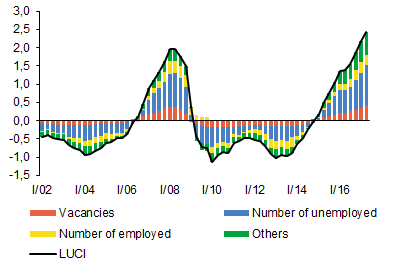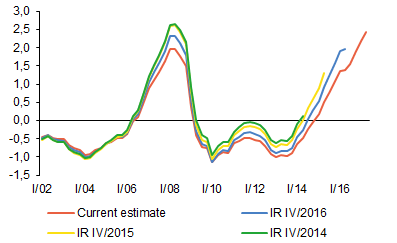The LUCI – the labour utilisation composite index
(Author: Jan Šolc)
Information from the labour market has long been calling for a comparison of the current situation with that observed at the peak of the previous cycle in 2008. Some time series describing the labour market (such as employment and the general unemployment rate) have now exceeded their historical highs/lows, while others (such as the converted number of employees and the share of unemployed persons) are still below the levels recorded at the peak of the previous cycle. The question is, then, which data are more important as regards the labour market, and how can we describe the individual pieces of information in aggregated form and thus comprehensively characterise the overall situation.
An aggregate evaluation of the labour market situation can be made using the LUCI1 – the Labour Utilisation Composite Index (see Chart 1). This index combines the information contained in 20 labour market time series using the principal components method. These time series include the number of unemployed broken down by length of unemployment, the share of unemployed persons, employment broken down by hours worked, the number of vacancies, etc. The first factor estimated in this analysis, which explains more than 50% of the variability of the time series used, is used to calculate the LUCI. The resulting index is then standardised. This means that for each estimate the long-term mean is zero. Positive values signal higher labour market tightness and negative values lower labour market tightness than the long-term average. The time series are merged into several representative categories for clarity of presentation.
Chart 1 (BOX) The LUCI and its basic decomposition
The current labour market tightness is the highest since 2002
(index; vertical axis shows standard deviations)

The LUCI has a number of advantages. Labour market data become available after a relatively short time lag and, most importantly, are subject to minimal historical revisions. This may assist in timely identification of the cyclical situation on the labour market, which hardly changes over time as a result of revisions of past data. In addition, the use of multiple time series allows for more precise identification, as the aggregation of information reduces the effect of the noise present in each time series.
Simulations show that the index is stable over time. When the data sample is shortened to the periods available in each past Inflation Report, it can be seen that the revisions almost exclusively affect the heights of the peaks of the cycle (see Chart 2). By contrast, the qualitative assessment of the position of the labour market in the cycle (more or less tight than the long-term average) remains mostly stable.
Chart 2 (BOX) Historical simulation of the LUCI
Shortening the time series reveals that the index is stable over time as far as the estimated phase of the cycle is concerned
(index; vertical axis shows standard deviations)

According to the LUCI, the labour market has been showing significant and increasing tightness for some time now. From the long-term perspective (since 2002), the labour market situation is currently associated with record high pressure (see Chart 1). All of the component indicators – many of which are also at record highs – are contributing to this pressure.
1 The LUCI is an index that aggregates information from individual labour market variables. The calculation of this index was inspired by a similar index used by the central bank of New Zealand – see Jed Armstrong, Gunes Kamber and Ozer Karagedikli (2016), Developing a labour utilisation composite index for New Zealand, No AN2016/04, Reserve Bank of New Zealand Analytical Notes series, Reserve Bank of New Zealand.